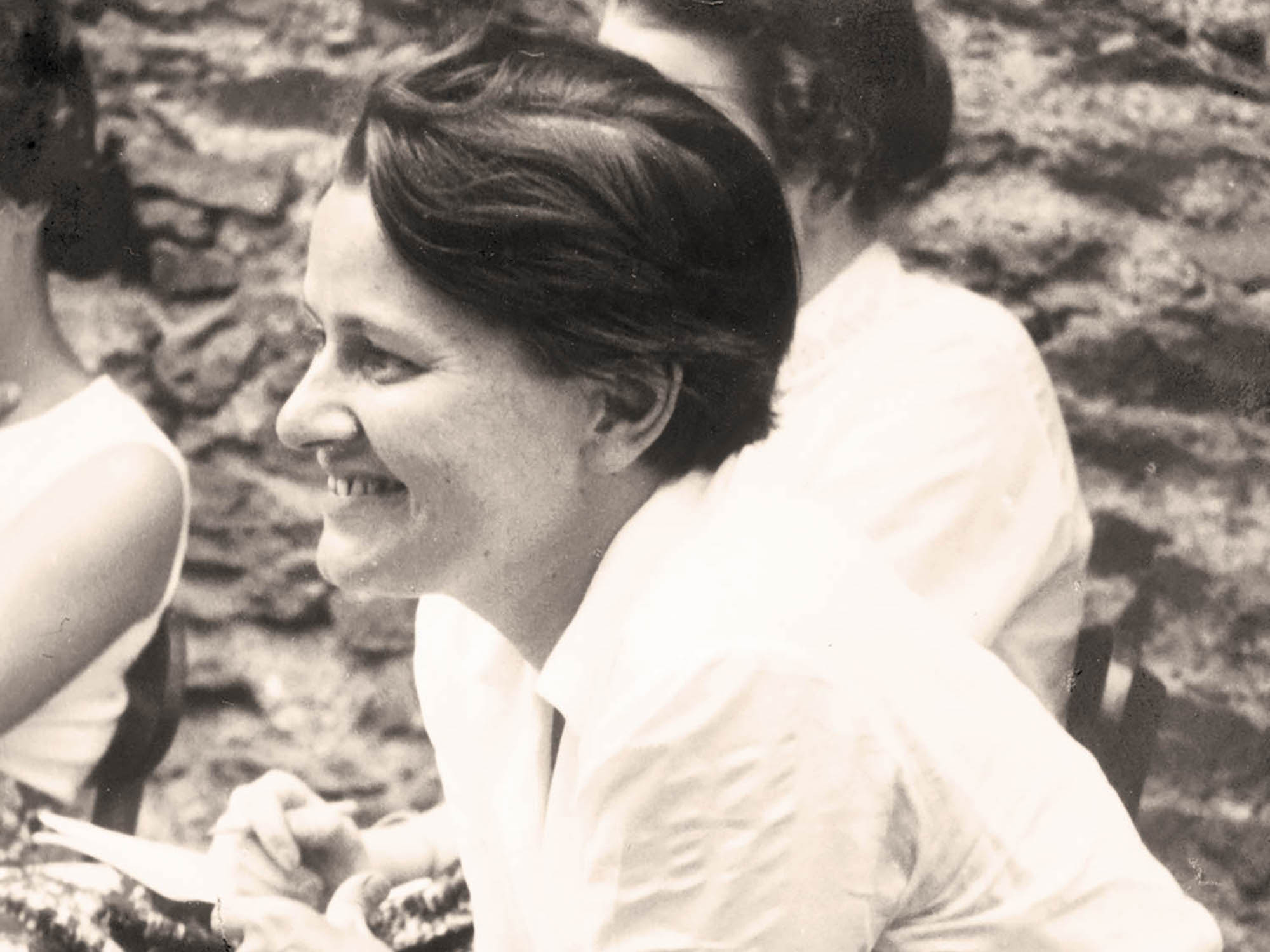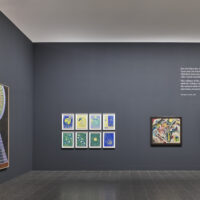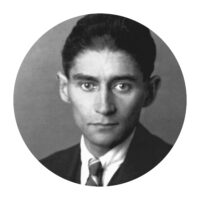If Renate Riemeck (1920-2003) is known at all today, it’s as Ulrike Meinhof’s foster mother1 or perhaps as the author of anthroposophically oriented history books. That her name is largely forgotten a signature of her life, which itself is a mirror of the tragedy of German history in the twentieth century with all its fractures. With considerable courage and commitment, educationalist and writer Albert Vinzens2 has tackled the biography of this controversial historian and pacifist, who for many anthroposophists was too materialistic, for Marxists too Christian, for Christians too anthroposophical, for right-wingers too left-wing, and for left-wingers too right-wing, and too heavily burdened with a “brown past” [braun Vergangenbeit – a connection to Nazism].
After studying history and obtaining her doctorate in Jena, in the post-war years, Renate Riemeck built a remarkable career in teacher training in the young Federal Republic of Germany, where, as a charismatic and popular lecturer, she influenced generations of future teachers. She was soon given tenure, which made her socially secure but at the same time meant a dubious middle-class status. As the youngest female professor in post-war Germany, she encountered an unpleasant mixture of arrogance and guardedness from her academic colleagues. On her 35th birthday, the professor took up her fourth post at what was then the Wuppertal Teacher Training College [from 1972, Wuppertal University], teaching history and political education. As Vinzens describes it, her aim was not only to focus attention on the external object of research but also to explore oneself and one’s own consciousness. For her, the experience of one’s own inner life was an important part of scientific insight, and she combined scientifically proven facts with committed personal positions, which not infrequently ended with a call to action. Thus, Riemeck was not only active as an academic lecturer but also, through her personality, as an exemplary, committed woman of her time, as many testimonials from her former students attest.
Riemeck had been a member of the Social Democratic Party (SPD) since the end of the war but increasingly distanced herself from the party line. She opposed nuclear armament, publicly advocated the recognition of the controversial Oder-Neisse border between Germany and Poland, and unwaveringly called for peace and understanding with East Germany and the Kremlin. At that time, in the middle of the Cold War, such views were considered defeatist and a threat to the constitution. A veritable witch hunt began against the “communist” professor who was indoctrinating the next generation of German teachers. In 1960, the North Rhine-Westphalian Ministry of Education and Cultural Affairs banned the controversial college lecturer from conducting examinations (which led to the first-ever student sit-ins), and shortly afterward she put an end to the mud-slinging and handed in her resignation as a college professor.
One chapter that has not yet been addressed is Riemeck’s position during the Nazi era, which Vinzens now sheds light on in a non-polemical way: Riemeck was a member of the Nazi Party from 1941 to 1943, apparently for purely opportunistic career reasons, namely to be able to do her doctorate (title of dissertation: Die spätmittelalterlichen Flagellanten Thüringens und die deutschen Geißlerbewegungen.Ein Beitrag zur Geschichte des deutschen Ketzertums [The late medieval flagellants of Thuringia and the German flagellant movements. A contribution to the history of German hereticism]). The fact that she left the party again when she received her doctorate also speaks for a party membership that was strategically motivated.
What is incriminating with regard to her biography, however, is not so much her Nazi Party membership, but her later persistent and proactive denial of this membership (pp. 82, 90, 378). Vinzens states without compromise that “admission to the Party without a person’s own knowledge and without a personally signed application can be ruled out”. And that it is something that was forgotten or repressed is unlikely given the calculated decision to leave the party right after her doctorate. So such forgetting or, as here, denial on the part of an intellectual and moral authority such as Riemeck is rather unsettling (comparable with the cases of the seminary director Friedrich Benesch, the writer Günter Grass, or the German scholar Wilhelm Emrich). This is further exacerbated by the fact that Riemeck, with an astonishingly naïve political lack of concern, invited the former Jena professor and SS-Hauptsturmführer [captain] Günther Franz to collaborate on her historical publications after the War and even asked him to substitute for her during her semester abroad as a lecturer in England in 1950. Vinzens views Riemeck’s actions after the War positively, as being determined “by a kind of roll-up-your-sleeves-and-get-on-with-it approach and a view that cannot be swayed by any doubts or critical questions.”
From Politics to Anthroposophy
Riemeck was similarly “blind in her left eye” for most of her life. The German Peace Union (DFU), which she co-founded a few days after her resignation in 1960, was labelled a “communist front organisation” by the conformist Social Democratic Party of Germany (SPD), which feared for its membership (and, as was subsequently revealed, the DFU was in fact supported by East Germany to the tune of millions). Riemeck quickly became the figurehead of the extra-parliamentary opposition and corresponded with Albert Schweitzer, Bertrand Russell, and Linus Pauling. With the construction of the Berlin Wall in 1961, Riemeck’s desire for West-East understanding imploded—a terrible turning point in her life. Riemeck moved to the vicinity of Freiburg, focussed her work on writing, and soon withdrew from active politics.
She fostered contact with anthroposophical circles in Freiburg and Dornach, with Gerhard Wehr, the eurythmy therapist Daniela Armstrong, and the publisher Herbert Hillringhaus, the husband of her doctor Ruth Jensen. She published her first essay on central Europe in Hillringhaus’ journal Die Kommenden in 1964, followed a year later by the collected essays in her successful book Mitteleuropa. Bilanz eines Jahrhunderts [Central Europe. Account of a century], in which she adopted Steiner’s concept of central Europe, idealist German culture and the mission of the German spirit in a fairly unfiltered way. This irritated the community of historians in which she enjoyed a certain degree of recognition. Numerous other publications followed, on Jan Hus (1966) and the pedagogue Amos Comenius (1970), on the history of the Councils (1985), on the fate of heretics (1986) and on the French Revolution (1988), as well as editions of the early Goetheanists (1980/81), and finally the late Marburg lecture series Klassiker der Pädagogik [Classics of education] (posthumous 2014).
Give Up, Ulrike!
Another thread that runs through Riemeck’s life is her destiny as Ulrike Meinhof’s foster mother. In 1940, while studying in Jena, Riemeck moved into the household of widowed fellow student Ingeborg Meinhof as a lodger and quickly became besotted with one of her two daughters, six-year-old Ulrike. Riemeck was subsequently to get to know many more children as a teacher, but none of them were as appealing, empathetic, adventurous, and at the same time as devout as Ulrike Meinhof, she recalled. After the sudden death of Ingeborg Meinhof, Renate Riemeck took care of the two orphans and later raised them together with her partner, Holde Bischoff.
She soon had a lively conversation partner in the adolescent Ulrike and later both became authors for the left-wing magazine Konkret, until Ulrike, now a journalist, was radicalised by the visit of the Shah and the murder of Benno Ohnesorg (1967), and finally by the assassination attempt on Rudi Dutschke (1968). Until then, her weapon had been the word. Now she wrote: “Protest is when I say I don’t like something or other. Resistance is when I make sure that what I don’t like no longer happens.” In 1970, she went underground and turned to the “urban guerrilla” movement, organising and being involved in the escape of the imprisoned terrorist Andreas Baader. Later, Baader’s escape on May 14, 1970, came to be regarded as the birth of the Red Army Faction (RAF). This also meant a break with Renate Riemeck.
Previously, Riemeck had been monitored by the domestic intelligence service as a pacifist and because of her contacts with the East; now she was also being shadowed as Ulrike Meinhof’s foster mother. For Riemeck, the break with Ulrike Meinhof was a disaster, as Vinzens writes perceptively. Ulrike had been like a star over her life for 30 years. On November 18, 1971, Riemeck published a courageous appeal in the magazine Konkret with the title “Give up, Ulrike!” But it was too late; the alienation was total. Meinhof was arrested six months later, and four years later, she died in the high-security prison in Stammheim.
During his research, Vinzens repeatedly encountered obstacles and complete rejection from potential interviewees and institutions with regard to this arena in particular. The life of Renate Riemeck, and within it probably above all her connection with the most intelligent of all the RAF members, is apparently still taboo in Germany, as is the as yet-to-be-worked-up history of the RAF. It also fits in with this that Vinzens did not find funding for his biography project from a single German foundation, but only from two Swiss ones.
Vinzens has not presented a whitewash with his book, but rather a differentiated, critical and document-supported rehabilitation of frequently maligned Renate Riemeck (for example by Kristin Wesemann or Jutta Ditfurth)—albeit without uncritically placing her on a pedestal. He had access to Riemeck’s unpublished papers, knows how to categorise the sources, how to read and intelligently evaluate them, and how to tell an exciting story. To do this, he managed to track down and interview still-living contemporary witnesses. The result is a portrait of Riemeck before which we stand in both admiration and bewilderment and to which we can adapt Conrad Ferdinand Meyer’s words about Ulrich von Hutten: “She was not a cleverly conceived book, she was a human being with the contradictions that a human being has.”
See Also “Renate Riemeck’s Philosophy of Education”, the Goetheanum Weekly, Issue 27/28, 2024
Unless otherwise stated, all images are from the Renate Riemeck estate, Hamburg Institute for Social Research (HIS)

Albert Vinzens, Dr. phil., grew up in Graubünden. He was an extreme climber in his younger years, then studied philosophy and history in Zurich, Munich and Basel and completed his doctorate on Friedrich Nietzsche. Today he lives as a freelance author in Kassel. Publications include essays and books on extreme living, thinking and play as well as biographical texts on Nietzsche, Beuys and Goethe. Most recently, he worked on the major illustrated biography of Rudolf Steiner.
Translation Christian von Arnim
Footnotes
- Ulrike Meinhof was a German left-wing journalist and founding member of the Red Army Faction (RAF) in West Germany, a militant Marxist-Leninist group active in the 70s, 80s, and 90s. The RAF was often called the “Baader-Meinhof Gang.”
- Albert Vinzens, Renate Riemeck. Historikerin, Pädagogin, Pazifistin. 1920–2003 [Renate Riemeck. Historian, Teacher, Pacifist. 1920-2003], (Göttingen: Wallstein Verlag, 2023, 408 pages, ISBN 978-3-8353-5452-4, €28.00).





